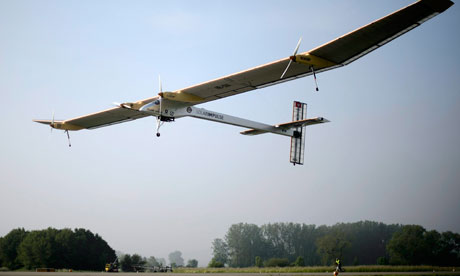
An experimental solar-powered airplane took off from Switzerland on its first transcontinental flight on Thursday, aiming to reach North Africa next week.
Pilot Andre Borschberg will fly the jumbo jet-size Solar Impulse plane on its first leg to Madrid, Spain, by Friday. His colleague Bertrand Piccard will take the helm of the aircraft for the second stretch of its 1,554mile journey to the Moroccan capital Rabat.
Fog on the runaway at its home base in Payerne, Switzerland, delayed the take off by two hours, demonstrating how susceptible the prototype single-seater aircraft is to adverse weather.
"We can't fly into clouds because it was not designed for that," Borschberg said as he piloted the plane with its 63meter (207ft) wingspan towards the French city of Lyon at a cruising speed of just 43.5mph.
Before landing in Madrid in the early hours of Friday, Borschberg will face other challenges, including having to fly over the Pyrenees mountains that separate France and Spain. He has a parachute inside his tiny cabin that he hopes never to use.
Piccard – the son of an undersea explorer Jacques Piccard and grandson of balloonist Auguste Piccard – will have to cross the windy Straits of Gibraltar from Europe to Africa.
The team has been invited to Morocco by the country's King Mohammed VI to showcase the cutting edge of solar technology.
Morocco is about to start construction on a massive solar energy plant at Ouarzazate, part of a country-wide solar energy grid with a capacity of 2000MW by 2020.
The solar flight is described as a trial for a round-the-world flight with a new aircraft in 2014. That trip will include stops in the US, said Borschberg.
In 2010, the Swiss flew non-stop for 26-hour to demonstrate that the 12,000 solar cells attached to the aircraft can soak up enough sunlight to keep the plane airborne through the night. A year later, he took Solar Impulse on its first international flight to Belgium and France. The project began in 2003 and is estimated to cost about $100m (£67m) over 10 years.

